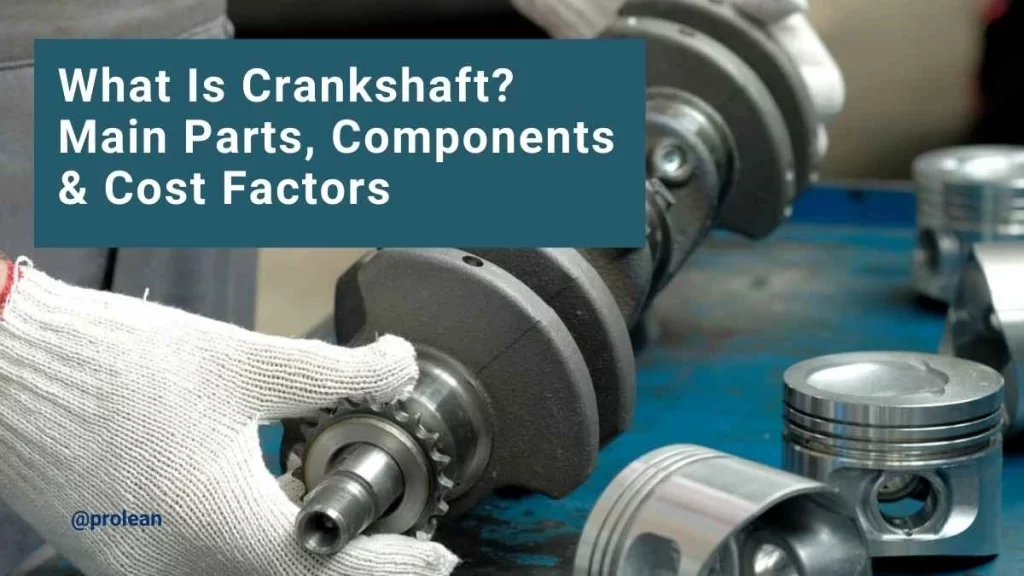
Is your vehicle’s engine functioning at its best? The crankshaft, a vital engine part, plays a significant role. Failure in the crankshaft can lead to the inability of the vehicle to run. The crankshaft makes sure that energy retrieved from combustion is effectively transformed into mechanical power. If this malfunctions, your engine can fail!
What is crankshaft? The crankshaft is a central part of car reciprocation engines. It converts the up-and-down motion of pistons into rotary motion to power the wheels. Moreover, it helps bear considerable stress and pressure and effectively operate the automobile.
The crankshaft connects to various other engine components, transmitting power. In upcoming sections, we will explore its types, components, manufacturing process, and its critical role in vehicle performance.
What Is Crankshaft?
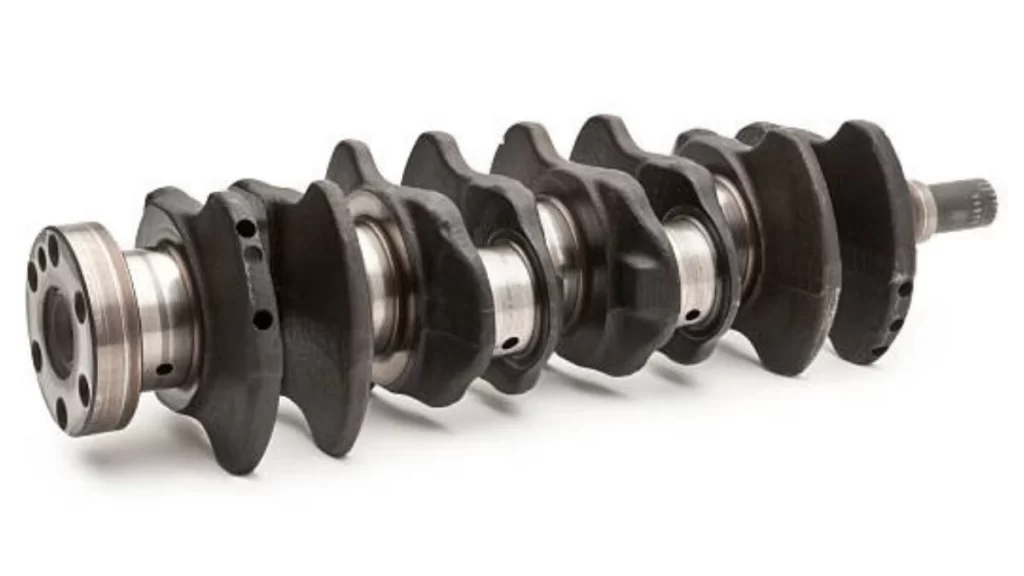
Image Name: Crankshaft
A crankshaft is a rotating component connected with a crank mechanism to receive its motion. It transforms the reciprocal straight movement of the piston into a rotational one for supporting the engine operation. This crucial part of the engine’s power system plays a vital role in vehicle movement.
Located inside the engine block, the crankshaft makes use of connecting rods. These rods convert the linear oscillatory piston motion into rotary ones. The crankshaft’s rotational force drives the flywheel, which in turn powers the vehicle’s wheels for smooth motion. (Read more about the Precision turning process and how it achieves high-accuracy results in manufacturing)
How Does the Crankshaft Work in Your Car Engine?
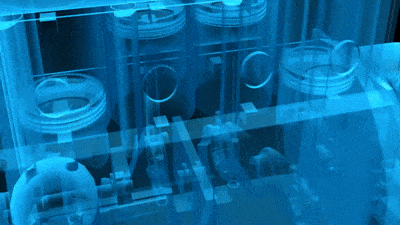
Image Name: Crankshaft Working Animation
What do crankshafts do to your engine? The crankshaft in your engine is typically important for transforming the force. It consists of several parts and elements through which the front of your vehicle moves forward. Crank pins and cranks, connection rods as well as vibration-dampers reduce crank thrust and maintain the crank ride nicely. Below, we’ll break down the crankshaft’s operation in a 4-stroke engine.
Downward Motion of the Piston
Initially, the piston descends from the top dead center point (TDC) down to the bottom dead center (BDC). This occurs when an inward pressure in the combustion chamber has forced the piston downwards.
When the piston moves, it is linked with the crankshaft through the connecting rod and so transfers its motion. You’ll notice that this linear motion is transferred directly to the crankshaft, which begins to rotate.
Motion Transformation
Next, the crankshaft takes over. It transforms the to and fro movement of the piston into circular or rotational movement of the crankshaft. This transformation is key to your engine’s functionality. Once the crankshaft turns, it passes this rotary motion to the camshaft, allowing the engine cycle to operate.
Compression Phase
As the crankshaft rotates, it connects to the camshaft and opens the intake valve. This enables the air-fuel mixture to get into the combustion chamber. If the chamber is filled, the piston begins moving up from the bottom dead center to the top dead center thus compressing the mixture.
At this upward stroke, the camshaft reminds closure of both the inlet and exhaust valves of the engine. This action completes the compression phase and also marks the first full revolution of the crankshaft.
Ignition Phase
After the compression, an ignition phase starts. The heat produced by the ignition spark results in the explosion of the air-fuel mixture following which the piston is pushed down in a power motion. As the piston moves, it pushes the connecting rod, transferring the motion to the crankshaft.
Flywheel Motion
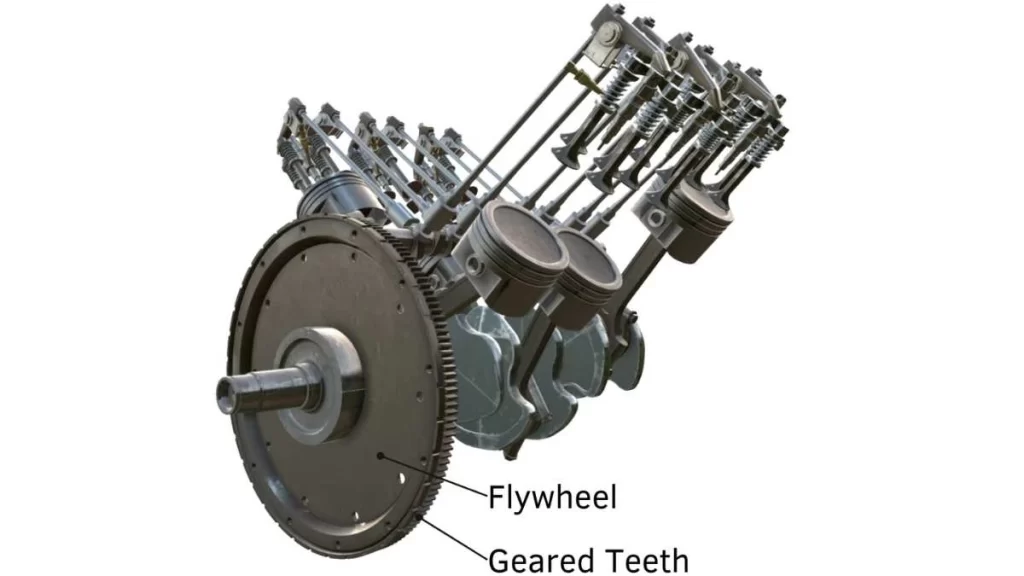
Image Name: Geared Flywheel In Crankshaft
The crankshaft joins the flywheel, on one of the ends, through a connecting bush. With the help of the crankshaft, energy is transmitted to the flywheel when the piston moves. The energy is stored in a flywheel and then drawn back as the engine is maintained steady and unvarying. This will make you experience an energy transfer as the flywheel supports the stabilization of the rotational speed to enable your vehicle to move continually.
Exhaust Stroke
Lastly, down moves the piston to start another process known as exhaust stroke. The camshaft motion is produced by the downward motion of the piston opening the exhaust valve. As such, the exhaust gases are permitted to discharge the combustion chamber. The crankshaft completes the exhaust stroke, preparing for the next cycle.
If you’re looking for a trusted, one-shop-stop solution for your auto car components manufacturing, Proleantech is here to help. Feel free to reach out to us for any queries.
Try Prolean Now!
Types of Crankshafts: Which One Powers Your Engine?
Crankshafts come in various types, each designed for different applications and manufacturing processes. It may contain a fully built-in crankshaft, built-in crankshaft billet, cast and forged crankshaft, single piece, welded piece, etc, or semi-built-up crankshaft.
Now let us discuss these types and shed light on the most relevant features of each type.
Fully Built Shaft
An unbuilt crankshaft is made of separate components. The crankpin, main journals, and the crank web are shipped separately for assembly. As soon as the parts are machined up and the journals and crankpin have been bored into the crank web, they are assembled. Shrink fitting ensures that each nut and bolt is in the right place. This type is usually narrower in diameter than others.
Welded Shaft
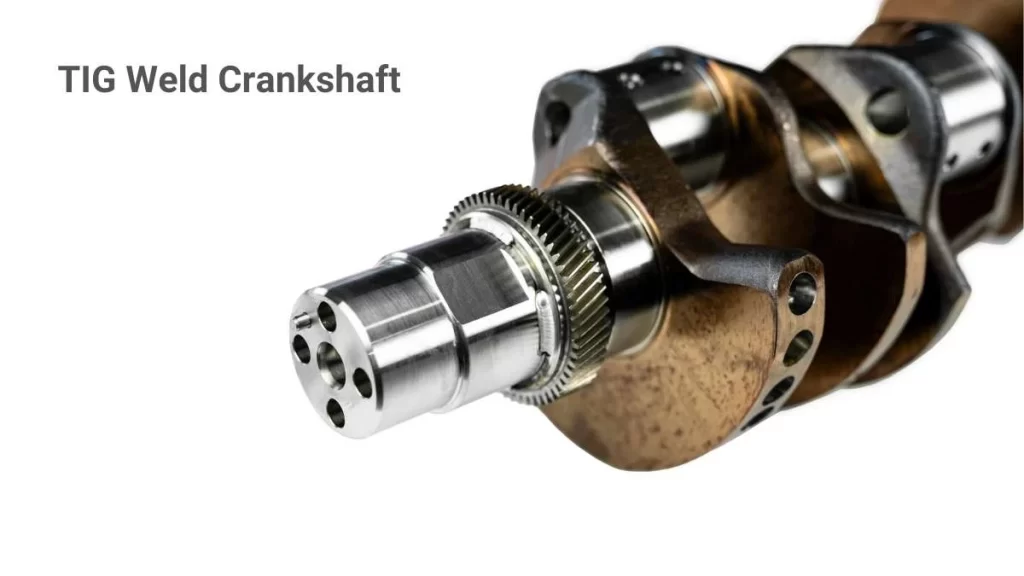
Image Name: TIG Welded Crankshaft
Welded crankshafts are made by joining the two main journals on the one hand, the crankpin and the crank web on the other. Subsequently, the assembly components are submerged arc and welded together to increase the structural frame integrity. The crank webs are comparatively thin, and the journals are usually not under stress.
Forged Crankshaft
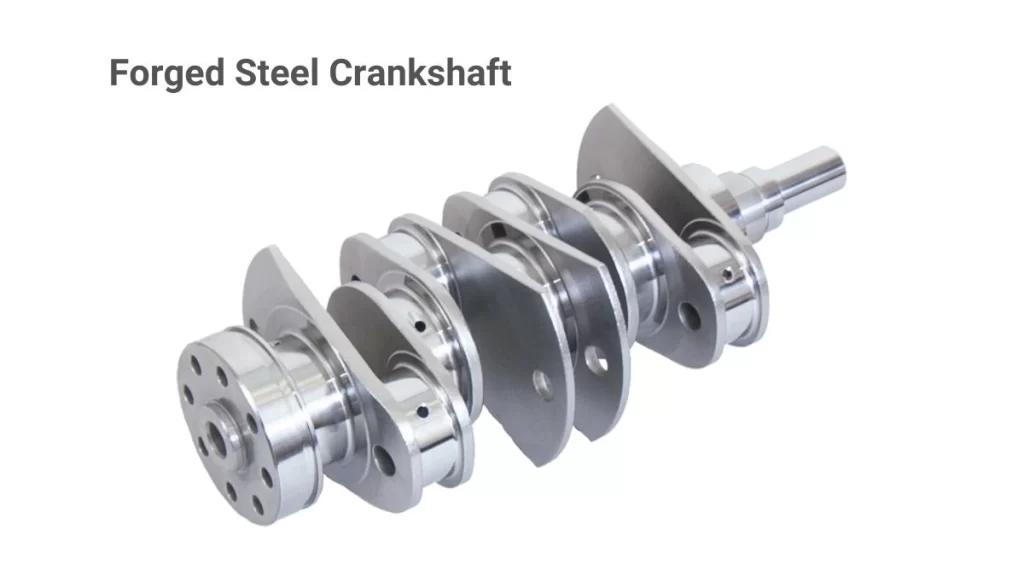
Image Name: Forged Steel Crankshaft
Forged crankshafts are strong material components, which make them well-suited for high-stress engines such as 16-valve car models. Crankshafts made from a die are highly precise have high dimensional stability and can accommodate heat treatment. They are made to take high loads and can be useful in high-performance cars.
Solid Single Piece Crankshaft
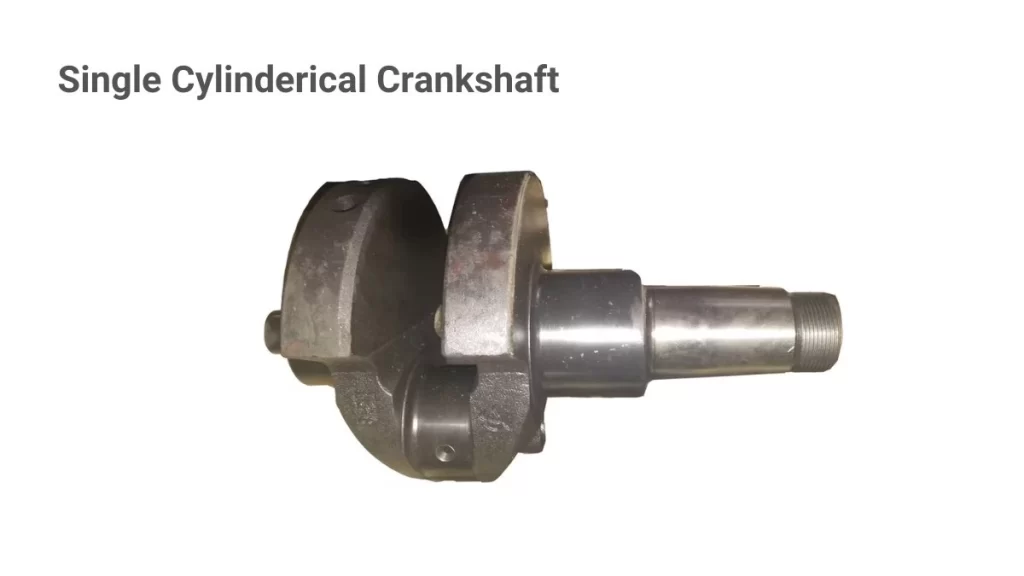
Image Name: Single Cylindrical Crankshaft
Single-piece type crankshafts are produced from forging or casting techniques owing to their sturdiness. These crankshafts are common in high-speed as well as low-speed engines.
The crankshafts are stiff regular connecting rods with bearings normally hatred on the cylinders. Such shafts are designed to endure the load and stresses produced during the engine operations.
However, keep in mind that torsional and axial vibrations can cause stress, especially in the main bearings.
Billet Crankshaft
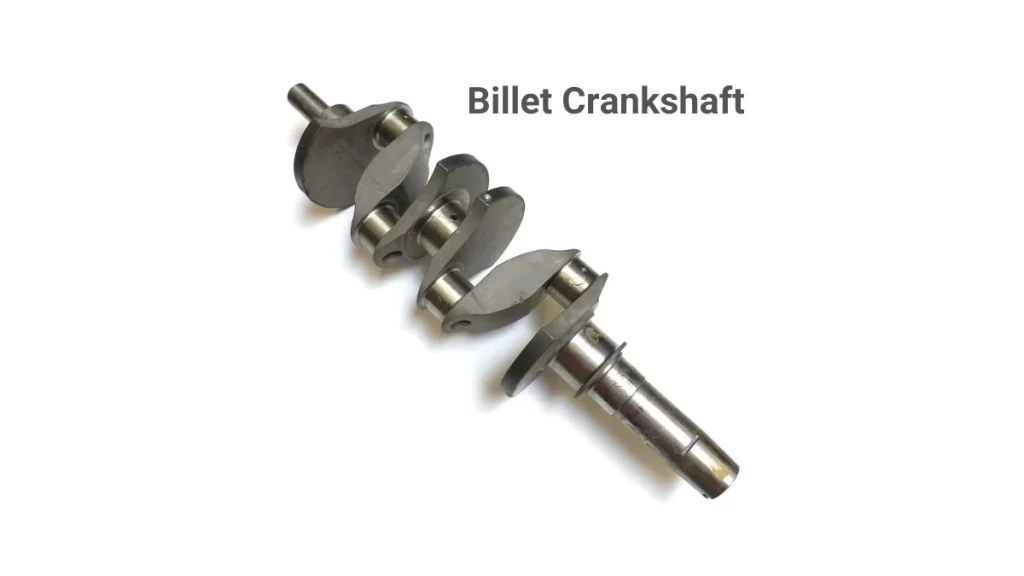
Image Name: Billet Crankshaft
Billet crankshafts are made from steel and sometimes from other materials including molybdenum, aluminum, chromium, and nickel. These crankshafts offer the major benefit of shorter machining durations while needing little balancing. Due to its material and construction method, billet crankshafts are the most dependable and long-lasting items on the market.
Cast Crankshaft
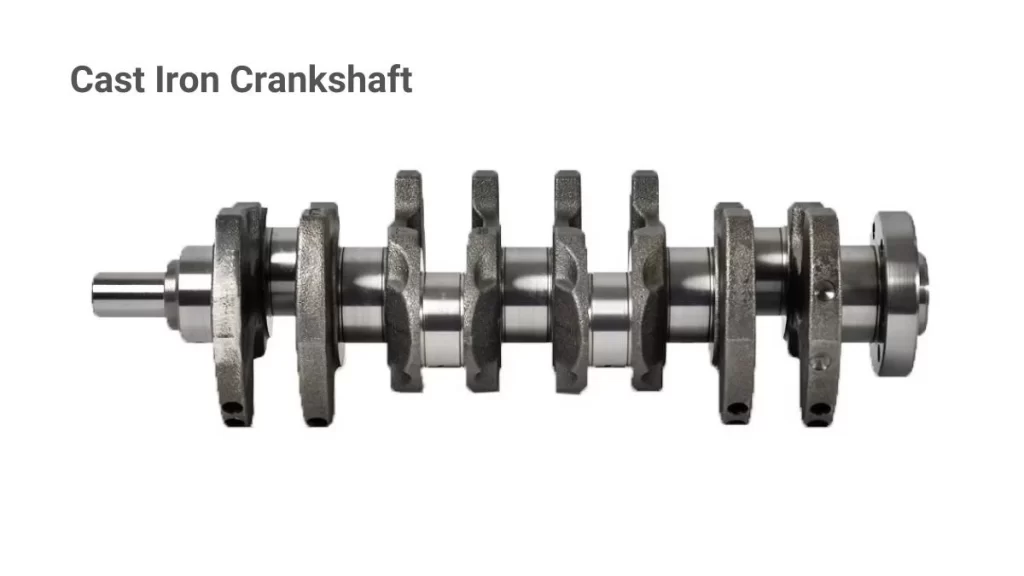
Image Name: Cast Iron Crankshaft
Cast crankshafts are typically made of iron through a casting process. They are often used in petrol and diesel engine cars. The cast crankshafts are cheaper and easily machined; factors that make them favored by most manufacturers. Their uniform metal grain structure enables them to handle loads from various directions.
Semi-Built Shaft
The semi-built crankshaft is forged and shrink-fitted, with the crank webs attached to the main bearings. In applications where bending and or high shear stress is expected; these shafts can be seen in the engines.
Try Prolean Now!
Common Components of crankshaft
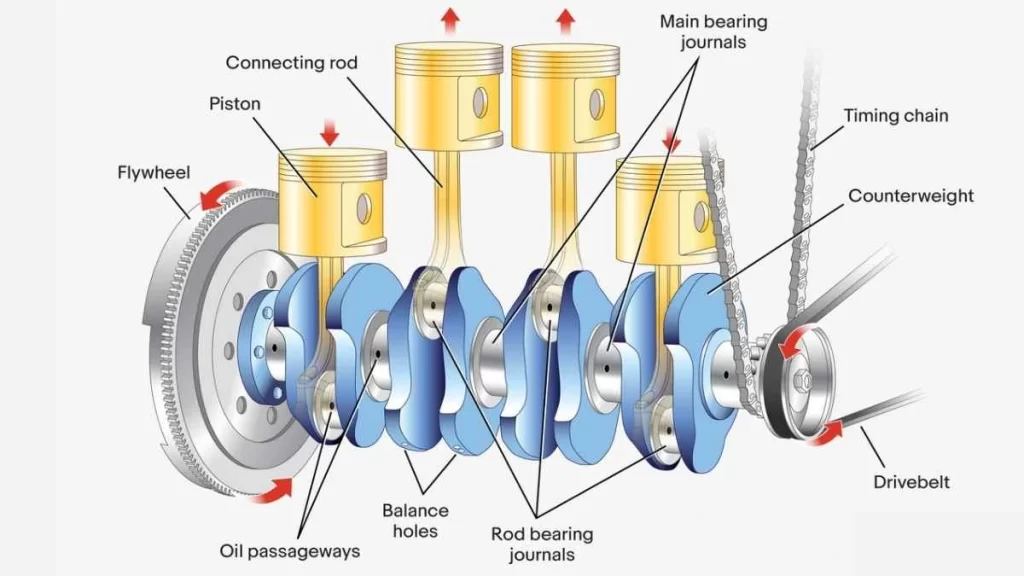
Image Name: Basic Components of Crankshaft
A crankshaft is comprised of several components. Lacking these components means a crankshaft is merely an iron beam. Crankshafts consist of main journals, counterweights, flywheel mounting flange and thrust washers, crank pins, crank webs, passage for oil, and seals. Now let us discuss the body components in some detail.
Main Journals
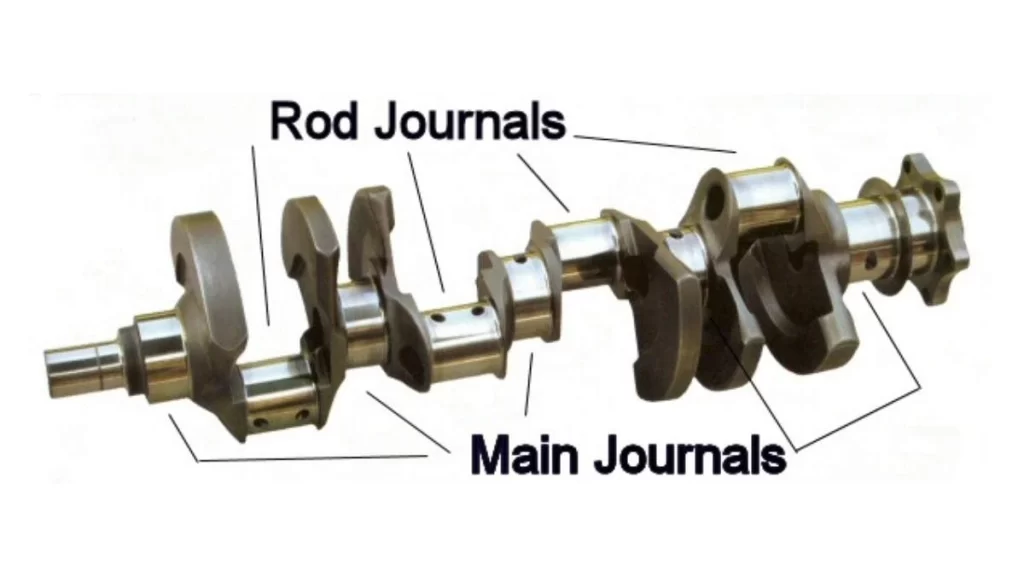
Image Name: Crankshaft Main & Rod Journals
Main journals are the crucial points where the crankshaft attaches to the engine block. These journals are provided with a bearing that supports the crankshaft and allows the rotation of the engine block around it.
Normally, there are two bearings in the main journals: Journal or roller bearings and the least is plain bearings. The type of bearing depends on the required torque by the engine and design type.
Counterweights
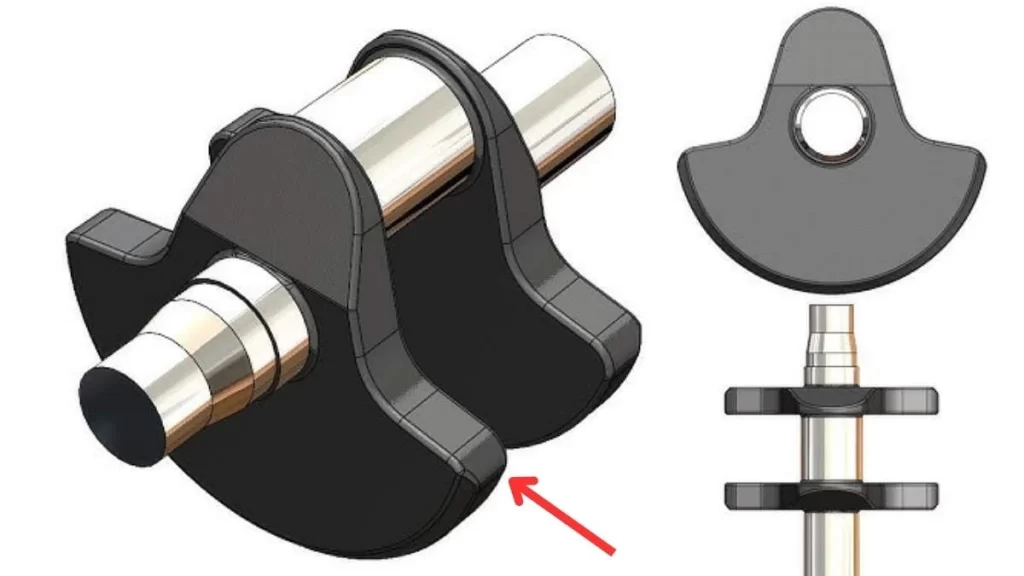
Image Name: Crankshafts Counterweights
Counterweights are provided on the crank web and their basic function is to balance the entire system when it rotates. Moreover, they help to dampen the entire system as the crankshaft rotates about its axis. Without them, engine speed could decrease due to unbalanced reactions. These forces are eliminated by counterweights and thus crankshaft gains higher RPMs and able your engine to run smoothly.
Flywheel Mounting Flange
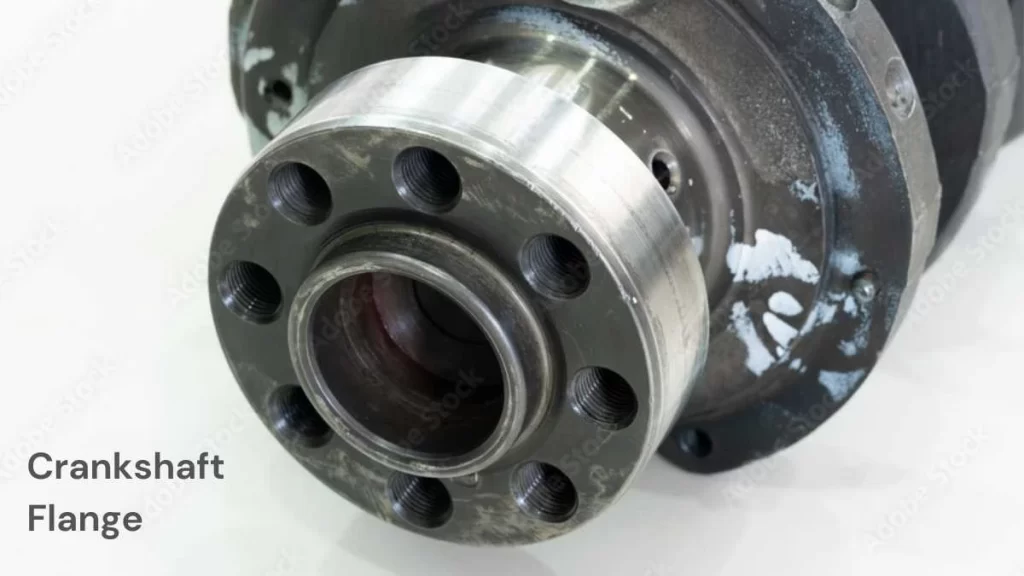
Image Name: Crankshaft Flange
The flywheel mounting flange is the part where the flywheel and the crankshaft are joined. During manufacturing, this portion of the crankshaft is often larger than the other to install the flywheel. The flywheel is responsible for maintaining momentum and reducing shock for the engine. While flange is used for holding things tightly in place.
Crank Pins
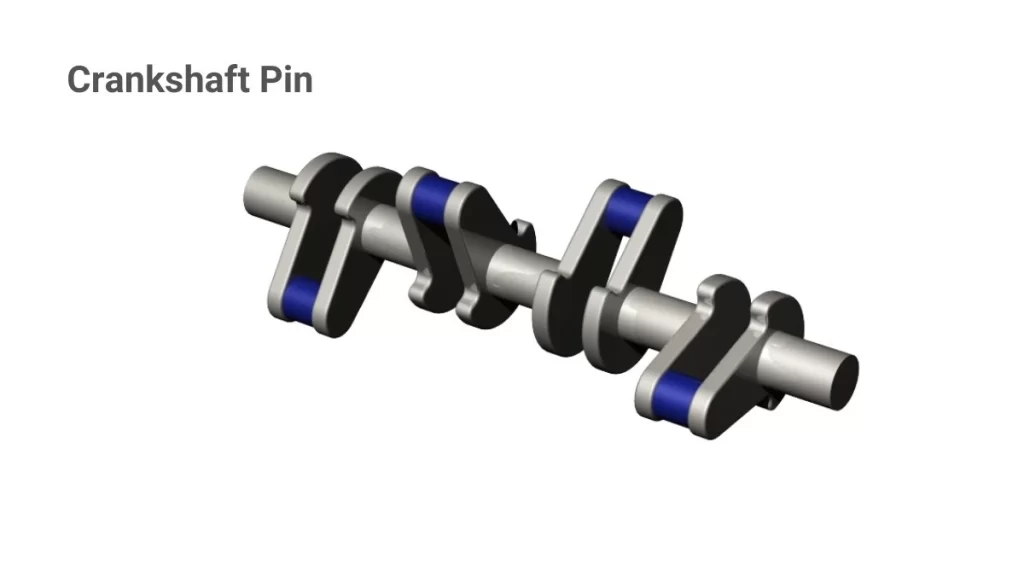
Image Name: Crankshaft Pins
Crank pins are significantly used in connecting the connecting rod to the crankshaft. This component is often referred to as the connecting rod journal or rod bearing journal; provided with a cylindrical surface to transmit the rotation force; exerted by the larger end of the piston rod.
Crank Web
The crank web is a slight projection between the main bearing journals and the crankshaft proper, which forms part of the main bearing upon which the crankshaft rests. This component assists in centering the forces through the crankshaft and maintaining most of the assemblies correctly aligned and balanced. It is crucial to increase the general rigidity and stiffness of the crankshaft.
Thrust Washers
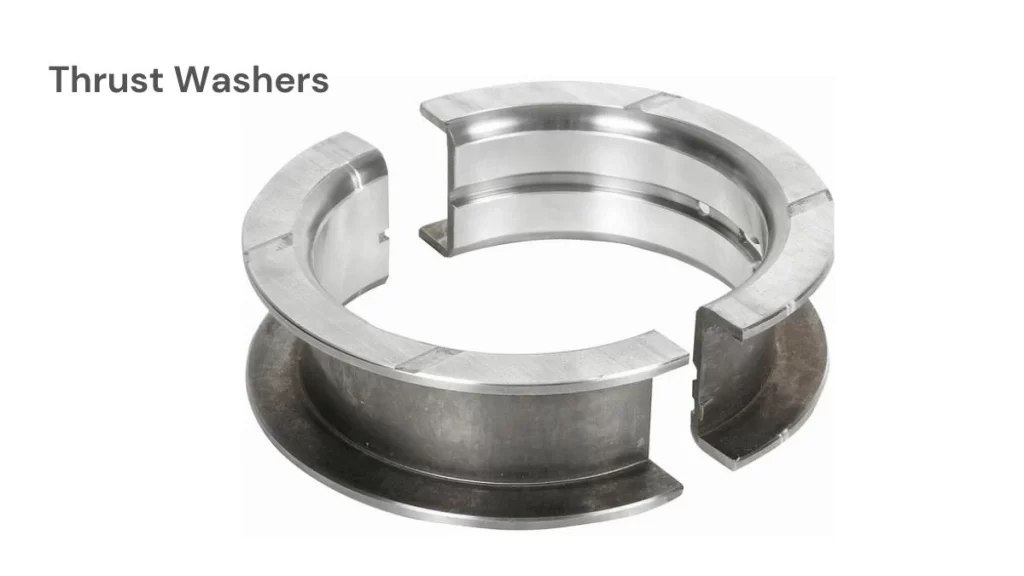
Image Name: Thrust Washers
Thrust washers prevent the crankshaft from moving vertically, in addition to its rotary motion. These washers can be located at definite positions along the crankshaft. They are used to maintain the crankshaft in position by establishing the right limits between the crank web and shaft.
In older engine models, the thrust washers were separate parts, but in the newer models, they are combined with the main journal bearings.
Crankshaft Oil Seals
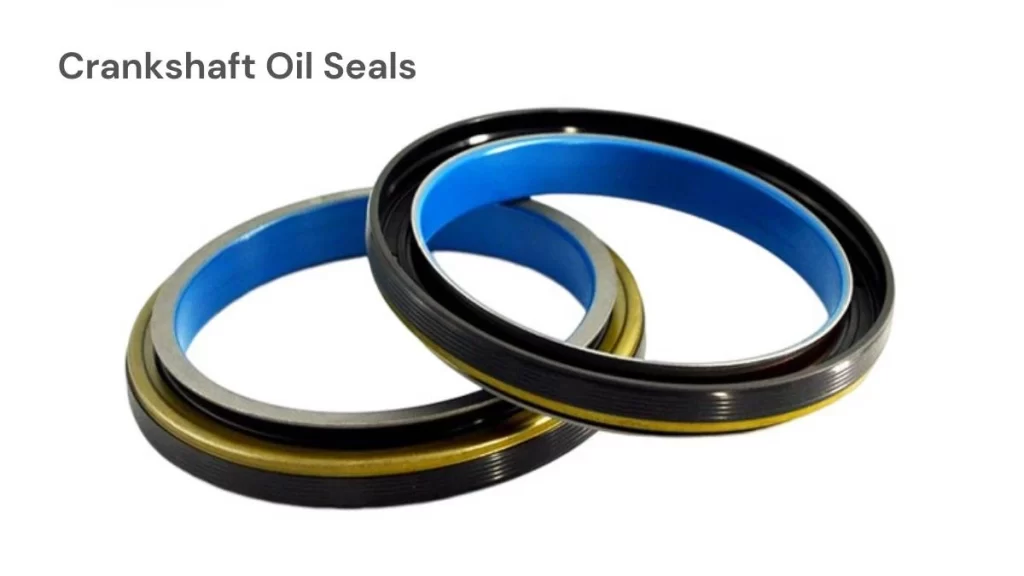
Image Name: Crankshaft Oil Seals
Oil seals are primarily stopping oil from seeping out of a crankshaft where it protrudes beyond the crankcase.
There are two main oil seals: one at the front and one at the rear. The front oil seal is located behind the pulley and timing gear, so can be replaced effortlessly. The rear oil seal sits between the rear main journals and the flywheel. This seal is made from rubber and comes with a molded lip, and a garter spring to hold it tightly in place.
Although the rear seal is cheaper than the front oil seal, it is challenging to replace and requires disassembling the clutch, transmission, and flywheel cases.
Factors Affecting Crankshaft Cost of Replacement
A crankshaft is not an easy part to replace. Several factors can impact the overall crankshaft cost, including the type of car you drive, labor costs, and the condition of your engine. Let’s figure out the common factors affecting the cost of crankshafts.
Labor Cost
Labor costs make up a good portion to replace a crankshaft on a car. When a crankshaft has to be replaced the mechanic has to pull the engine out of your car and then hoist it. This is no quick job. It’s time-consuming and for instance, when the mechanic has replaced the crankshaft, then the mechanic has to compile all the parts back together.
Therefore, it takes from several hours to a few days to replace or repair a crankshaft depending on the complexity involved. When a job takes longer to complete it means that the amount of money charged in labor will also be higher. So, keep in mind that the work required to replace your crankshaft will add to the overall cost.
Engine Condition
Another factor within the cost of replacement is the general condition of your engine range. When a crankshaft fails, there are always other components of a vehicle’s engine that suffer too. Especially, bearings, bearing rods, seals, camshaft, and the transmission may need to be replaced.
Some mechanics suggest non-destructive cylinder replacement, and cracked crankshaft test as well. These additional repairs and parts can quickly drive up the total cost of replacing the crankshaft. Therefore, if your engine is not in good health, you’ll likely receive a higher rate.
Cost of Crankshaft
The cost of the crankshaft itself is another major factor. Aftermarket crankshafts are comparatively rare, so most crankshafts are restored with OEM parts, which can be pricey. For luxury or performance vehicles, the price of these OEM parts tends to be higher. At the same time, as far as widespread automobiles are concerned, it’s possible to buy aftermarket parts comparatively cheaply.
The crankshaft type also influences the price. Whether you choose a new, secondhand, or remanufactured crankshaft will influence the overall price.
How Crankshafts are Made?
There are two primary methods for making crankshafts: Casting and Screw Forging. They both employ a variety of metals during the construction of strong crankshafts.
Casting entails melting casting metals such as cast iron and then pouring the molten metal into a mold to make the parts. The process prevents the crankshaft from shape irregularities or ensures the right size.
The screw forging process uses screws made from forged steel. A steel block is heated to glow red and forced to the preferred form under high pressure. This technique increases the crankshaft solidity and makes it resilient under strain engine rotations.
For better performance and structural strength, a few crankshaft components like the main journal are subjected to surface treatment processes including surface hardening.
(We refer you to read our detailed guide on the key differences between Swiss turning and CNC turning—explore their unique features and applications here!)
Why Prolean Tech Is Your Go To Choice For Custom Auto Accessories?
In crankshaft production, a higher skill expertise is needed. Not all machinists out there can produce optimal quality crankshafts that can meet the standard market requirements. So, you should choose the right professional like Prolean Tech for the best cnc turning & lathe service of custom car parts. Since the company has grown into an industry titan for over a decade.
We are a specialist auto parts manufacturing company that has been in the industry for over 2 decades. From prototypes to large-volume productions and superior-quality productions, you receive standards only. Our ISO-certified policies ensure you get the right parts on time; meeting our excellent delivery standards.
Choose Prolean for fast, efficient construction handled by our expert team! Call us now, and Get Quote Today!
Conclusion
Among all the components of an internal combustion engine, the crankshaft is crucial. Without it, engines would not move as they intended. The main crankshaft components include oil seals, main journals, and which contribute to the optimum crankshaft operation. In this article, we have precisely detailed certain aspects of crankshafts, their parts, functioning, and factors contributing to costs in crankshafts. So, readers can fully understand the significance and complexity of this critical component.
FAQ’s
Q1. How to extend the service life of the crankshaft?
To extend the crankshaft’s service life, ensure regular maintenance, use high-quality engine oil, avoid overloading the engine, and maintain proper lubrication. Regular inspections for wear and tear can also prevent premature failure.
Q2. What is the most common crankshaft?
The most common crankshaft type is the cast crankshaft. It is widely used in standard engines due to its affordability, and ability to withstand typical engine stresses.
Q3. How many types of crankshaft measurements are there?
Crankshaft measurements generally include journal size, stroke length, and crankshaft diameter. These measurements help determine the crankshaft’s compatibility with engine specifications.
Q4. What is the strongest type of crankshaft?
The forged crankshaft is the strongest type, as it is made from high-quality steel and is shaped under extreme pressure, making it highly durable and resistant to stress and fatigue.
Q5. What type of engine works without a crankshaft?
Wankel engines, or rotary engines, do not require a crankshaft. Instead, they use a rotor to convert pressure into rotary motion.
Q6. Can a car run without a crankshaft?
No, a car cannot run without a crankshaft. The crankshaft is essential for converting the pistons’ linear motion into rotary motion, which powers the vehicle’s wheels.

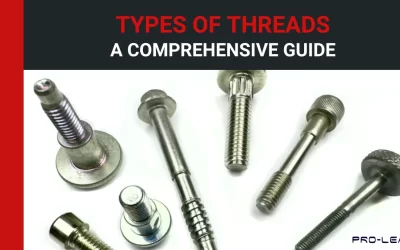
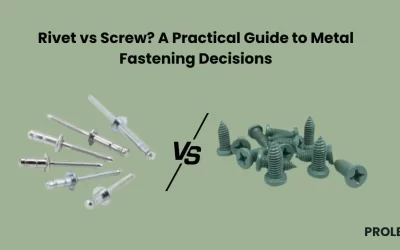
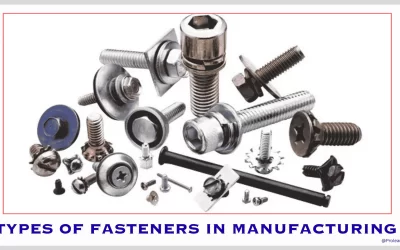
0 Comments